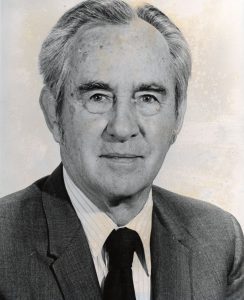Our history begins with The University of Alabama’s establishment of its first computer center, in 1961. In the early days, the center worked to encourage faculty and students to rely more on computer technology in their research and instruction. Bright, motivated undergraduates were employed to help staff the center; they received accelerated training in computer techniques and were then assigned to assist University faculty and staff with new and ongoing research projects. These students’ greatest contribution, however, was their role of actually teaching the researchers
about the computer’s capabilities. The experience was a great success.
In 1968, the Computer-Based Honors Program (CBHP) was established at The University of Alabama as the result of a grant from the National Science Foundation. The original objectives of the program as outlined in the 1968 recruiting brochure were:
“To train a selected group of academically outstanding undergraduate students in the use of computer techniques, with emphasis on relating their training to specific subject matter areas. Once trained, these students will be assigned to work with faculty and staff members in specific research and instructional programs, with the objectives of helping faculty and staff members acquire a broader knowledge of, and to develop new techniques in the use of, the computer as a tool in research and instruction. At the same time, the students will be broadening their own capabilities in applying the computer in specific areas of knowledge. The ultimate objective of the Computer-Based Honors Program is to produce students who will become leaders in application of computer techniques to various field of human knowledge.”
Throughout its first fifty years, the CBHP has remained true to these original objectives while expanding the focus of the program to meet the continuing advances in technology and the advent of the “information age”. The expansion of the program objective summarized in a 2017 recruiting statement is:
“The Computer-Based Honors Program, an interdisciplinary undergraduate research initiative, seeks to combine the talents, imagination and creative ability of bright, energetic undergraduate scholars who have been provided training in cutting-edge technologies and research techniques with faculty conducting research in all fields of knowledge to provide a basis for creative endeavor in the close relationship of student and faculty member. The objective of this initiative is to produce students who can work independently, think logically and reason abstractly allowing them to become leaders in their fields and contribute in meaningful ways to the breadth of human knowledge.”
As the program moves into the new era as the Catherine J. Randall Research Scholars, we look forward to the challenge to expand the program objective to develop students into leaders whose vision will improve the quality of life for any and all citizens of the world.
Through the generous and lifetime support of the H. Pettus Randall, IV family, the program moves forward into the next era as the Catherine J. Randall Research Scholars Program. The Randall Research Scholars Program seeks to honor the groundbreaking and inspired original program objectives while expanding the vision to encourage continued development of its student researchers as leaders in their fields who will contribute to the improvement in the quality of life for all citizens of the world.

Dr. Charles L. Seebeck was born July 19, 1908, in Charleston, South Carolina. He earned the A.B. degree in mathematics from the College of Charleston, the M.A. degree from Harvard University, and the Ph.D. degree from the University of North Carolina-Chapel Hill. Dr. Seebeck joined the faculty of The University of Alabama in 1939. When the first computer center was established at the Capstone, he served as its director. When the Computer-Based Honors Program was founded in 1968, he also served as its director, having been the driving force behind organizing and training the student assistants who were the forerunners of CBHP. Dr. Seebeck died in August 1982, and the University’s contemporary computer center is named in his memory.
In 1968, Dr. Charles L. Seebeck established the University of Alabama Computer-Based Honors Program for the creative and independent student. He realized through his work with students in the University Computer Center that the computer would be an ideal tool for teaching bright students. It would allow students a greater opportunity to be creative, to use their imaginations, and to work independently because not all of the answers in the field of computer science were known — particularly in the area of applications and systems work. With this in mind, Dr. Seebeck designed a proposal for a computer based honors program. His proposal resulted in the receiving of a grant from the National Science Foundation making the Computer-Based Honors Program a reality. Dr. Seebeck directed the Program until he retired in 1976. Dr. Thomas F. Gatts then replaced him as director.
Alumni Association for the Computer-Based Honors Program
To provide support for the Computer-Based Honors Program students, alumni and staff. To promote awareness of the Computer-Based Honors Program, and to be information technology ambassadors to our community and society.
To provide an opportunity for alumni and friends of the Computer-Based Honors Program to improve the program by providing additional scholarships, instructional enhancements, equipment and advice.
To sponsor meetings of its members and prospective members.
To provide recognition to devoted supporters who become members.